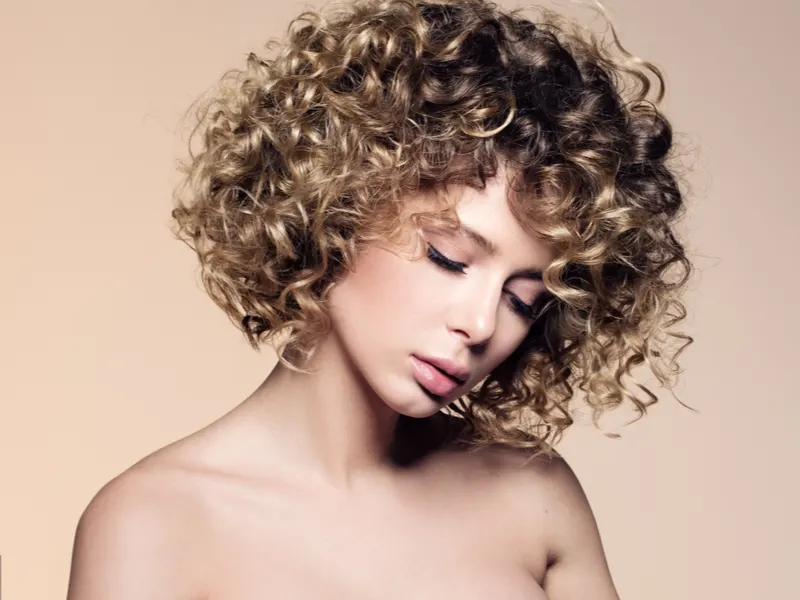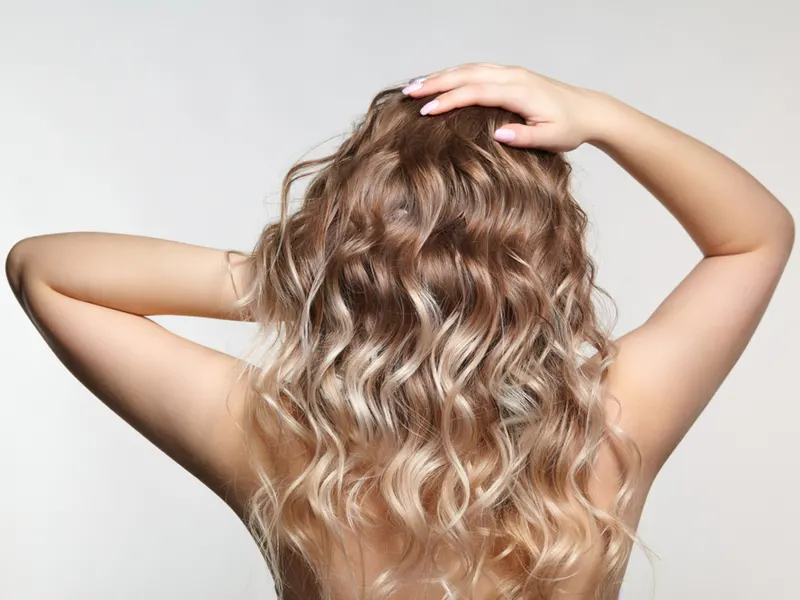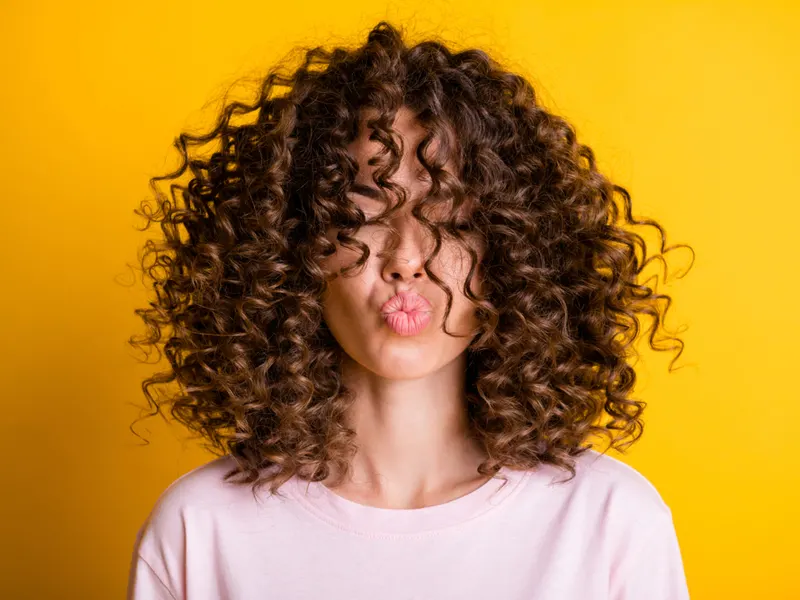Jump to:
Trying a new hairstyle can be daunting for curlies, especially when it comes to the age-old question of adding layers or not. Are you deep in the curly hair layers vs. no layers debate? Keep reading for all the information you need to make your decision.
Curly Hair Layers vs. No Layers: The Eternal Debate

Dmitry Bakulov/Shutterstock
Should rock curly hair with or without layers? The answer depends on your tastes, preferences, and (most importantly) hair type.
]You’ll need to consider how curly your hair is, what your hair texture is like, hair density, and what kind of layering you want. And, of course, an experienced stylist is a critical ally when considering layers.
Deciding whether to layer your curly hair is a personal decision, and unfortunately, plenty of curlies think that a blunt cut is the only option for them. Maybe they’ve got a terrible haircut in the past, or they simply think their hair will be too big or puffy.
Not to mention, there is always the fear of ending up with a triangle head. However, the idea that curly hair can’t be layered couldn’t be farther from the truth. Plenty of people rock a beautiful layered look. It’s all about knowing if it’s right for you.
In this guide, we’re going to cover all your questions, like:
- What are layers and who do they look good on?
- What are the benefits of a layered haircut?
- Differences between layered and non-layered hair
- Things to keep in mind when considering layers
Without further ado, let’s jump right in.
You Might Also Like:
- Should You Get Layers in Your Hair?
- How to Cut Layers in Your Hair
- How to Cut Face-Framing Layers
- What Are Face-Framing Layers?
- How to Cut Layers in Short Hair
What Are Layers?

Gladskikh Tatiana/Shutterstock
Before discussing whether you should get them, let’s start by examining what layers are. It may seem like a pretty obvious point, but it’s vital to understand what kind of hairstyle you will get if you go to a salon and ask for this cut.
A layered style is a way of cutting the hair that gives the illusion that different areas have been cut to different lengths. A stylist removes hair in such a way that some hairs end at different points than others. For example, imagine that they cut every hair to be nine inches long.
Cutting like this creates a layered cut, where the hairs at the top of the head are a different length than the hairs growing lower down. These layers can be connected, where they seem to flow, or disconnected, with one layer significantly shorter than the rest.
Whether you prefer a connected or disconnected look, people choose layers for many reasons:
- To add volume, especially in long hair that weighs itself down
- To redistribute fullness
- To get rid of bulkiness
Layers vs. Blunt Cuts
On the other hand, most people would say that in blunt styles, the stylist cuts all the hair to be one length. Because hair all stops at the same point, it’s easy to make this mistake.
However, the hairs originating at the nape of your neck are actually much shorter than the ones on the top of your head.
Differences Between Non-Layered and Layered Curly Hair
Before deciding whether to get layers, you should understand what changes you can expect to see in layered hair.
Layers Help With Definition
Ask anyone with curly hair what happens when it gets long, and they’ll tell you all about how their curls stretch out. Without layers, the effect is often a heavy, weighed-down look. However, well-placed layers can work wonders in creating definition.
How? Getting rid of the heaviness weighing the curls down allows curls to keep their natural, beautiful shape.
Layers can even help people with mid-length hair, who often have the same problem. These individuals can benefit too–they just need to ask for shorter layers, which will create that definition you’re looking for.
Layers Require More Upkeep
While regular haircuts are critical whether your hair is layered or not, they become more important when you have layers.
To keep them looking their absolute best, you’ll need to visit the salon frequently. Blunt cuts require less maintenance, so if you hate visiting your hairstylist, keep this factor in mind when deciding between the two cuts.
Read Next: How Often Should You Get a Haircut?
Layers Bring Out Color
If you want to draw attention to your colored/balayaged hair (who doesn’t?!), especially when it comes to highlights, layers are an excellent way to do so.
Because there are different lengths in the hair, it’s much easier to see the different tones. Layers can help bring out the subtle highlights in natural hair, too.
Layers Can Make Hair Look Better Kept
Sometimes non-layered hair can look a bit out of control, as some parts behave one way while other parts behave differently. Well-placed layers on the other hand can tame your hair and make you look like you put in some effort–even if the only person putting in the effort is your stylist.
Layers Create Better Movement
Layers favor curl movement, whereas non-layered hair has more structure that doesn’t allow for as much bounce. Some people like this movement, while others don’t. If you’re in the latter camp, you should probably avoid layers.
Layers Pump Up Fine Hair
Anyone with fine curly hair has probably dealt with dull, lifeless curls at one point or another. Non-layered cuts tend to exaggerate this effect, whereas layers can create the illusion of a fuller mane.
The caveat here is that layer length is critical. Short layers tend to look best on fine hair, as they create the most volume, but your stylist can help you decide what will work.
Layers Bring Out Unique Curly Features
Finally, a layered haircut can really help you personalize your look. Depending on your curl type and hair thickness, you can achieve a completely unique style, even from cut to cut. Layers allow you to hide bulky hair, create movement, and change volume by adding or removing it.
Should I Get Layers?

True Touch Lifestyle/Shutterstock
When considering getting your curly hair layered, here are some things to keep in mind.
Curl Type
Not all curls are created equal. Someone with 2C hair has entirely different styling needs than someone with 4C curls, which is why it’s vital to understand your curl pattern type.
To put it simply, some curl types look better than others when layered, so make sure you consider yours before deciding whether layers are right for you. For example, tight curls tend to look excellent when layered.
This type of haircut lets the curls move and volumizes them without adding a ton of extra weight, making them seem more vibrant and alive. On the other hand, adding lots of layers to loose waves will probably create a poofy look.
Hair Texture
There are three types of hair texture: coarse, medium, and fine. All three of these texture types can be layered, but some create better looks than others. In general, we can say that coarse hair looks the best with layers.
Medium textures come next, and fine hair is often challenging to layer successfully. However, just because you have fine hair doesn’t mean you can’t have layers.
As long as you apply the right kind (pro tip: avoid heavy layers), you can achieve a gorgeous look. Similarly, even though coarse hair is well suited to layers, the wrong kind can leave you with a disjointed style.
Hair Thickness
Those of you blessed with thick hair have probably noticed that it can feel heavy, especially with the wrong cut. As your hair gets longer, it starts to feel bulky.
At a certain point, this bulk starts to become extra noticeable and begins to acquire that unwanted triangular shape. Layers can help remove extra weight for a more flowy look.
Although layers are an excellent choice for curlies with thick hair, not everyone loves them. If you fall into this camp, you can create pseudo-layers by having your stylist get rid of bulk from the bottom sections of your head.
Face Shape
Be sure to consider your face shape, too. For those with straight hair, layers are almost universally flattering, regardless of face shape. Unfortunately, the same can’t be said for curls. The best candidates for layers are those curlies with round or oval faces.
This type of cut complements those shapes well, and as long as the layers are put in the right places, they can make you look glamorous.
However, if you have a square or a diamond-shaped face, it may be best to avoid layers. With these shapes, layers tend to create an odd illusion and may make your face look strangely long.
Maintenance
Are you looking to reduce the amount of time you spend caring for your curls? If so, you might consider rocking a layered look. You’ll have fewer hairs to contend with, and you’ll notice that you can put a lot less daily effort into drying and styling your hair.
However, keep in mind that what you don’t need to do every day, you’ll have to make up for in the salon. Regular trimming is essential to keeping your layered locks in tip-top shape.
Volume
Do you love big, voluminous curls, or do you prefer a more toned-down look? If you want your curls to be front and center for all the world to see, getting layers can help you achieve that goal.
On the other hand, if you want to play your curls down or just don’t like so much volume, layers probably aren’t right for you.
Frequently Asked Questions

Roman Samborskyi/Shutterstock
Can you layer short curly hair?
Yes! Shorter styles look amazing with layers, as long as you keep around two to three inches of length around the head. Textured pixie cuts also work well.
What products should I use to keep my curly hair from frizzing?
Whether you have layers or not, an excellent tip to keep frizz at bay is to apply a leave-in conditioner to your locks. If you have fine hair, you may want to try a regular conditioner instead, which shouldn’t weigh your hair down as much.
What are cascading layers?
Cascading layers are when the stylist cuts layers through the mid-lengths and ends of the hair. The result is a soft, bouncy, flowing look that suits long manes.
Does layering make hair thinner?
No, it doesn’t. Blunt cuts can actually make the ends of your hair look thin and scraggly, whereas layers help create the illusion of thicker hair.
What products should I use on my layered hair?
Because the goal of layers is to create more volume, it’s helpful to add a volumizing product to your hair care routine. You can find them in spray, powder, or cream form.
Curly Hair Layers vs. No Layers: Final Thoughts
So there you have it — all the need-to-know information for curlies considering layers. There are plenty of differences between the two styles, and ultimately, the decision is yours to make. Talk with your stylist to develop a plan of action that suits your hair type, texture, and density.
